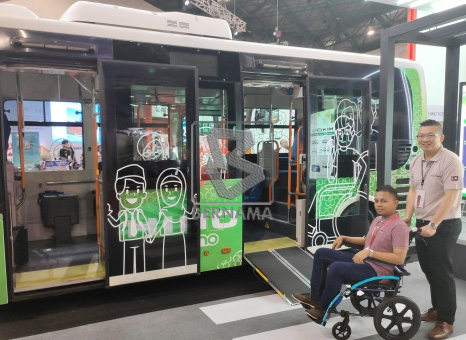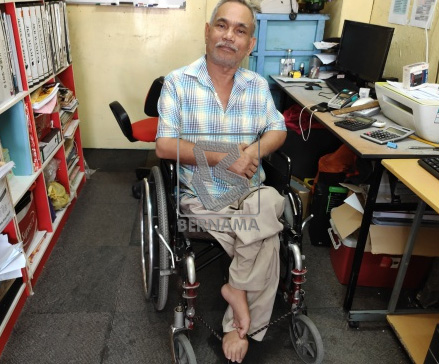For Malaysia’s persons with disabilities, low-floor minibus provides opportunity

Andrew Lee demonstrating how easy it is to push a wheelchair user up the Hino Poncho (Bernama)
Kuala Lumpur: Ever come across a person on crutches or in a wheelchair, struggling to board a bus?
Persons with disability (PWD) often struggle with public transportation as some are not designed with PWDs in mind.
Hino Motors Limited, however, is cognisant of such challenges and has designed a low-floor minibus to cater to PWDs called the Hino Poncho.
The bus was among the hundreds of commercial vehicles recently on display at the 2019 Malaysia Commercial Vehicle Expo (MCVE) in Seri Kembangan.
The Senior Manager of Hino Motors Limited, Andrew Lee said that the Hino Poncho was equipped with features designed for the benefit of PWDs.
“When it goes into operation, this bus will be the first of its kind in Malaysia meant for PWDs. The bus is equipped with an ‘ultra-low flow system’ – which means the step to board the bus is nearly as low as the ground – as well as a slide ramp.
“The Hino Poncho uses a ‘kneeling system’ which is a special button that can lower the left side of the bus near the doors so that PWDs in wheelchairs can board with ease,” he added.
Buses like the Hino Poncho are widely used in Japan and Hino sees the need to bring the bus into Malaysia’s market.
Hino Motors Limited is a subsidiary of the Japanese car maker Toyota Group, which has been operating in Malaysia since 1977. Its partner in Malaysia is MBM Resources Berhad.
The company has sold over 50,000 units of trucks and buses last year and the figure is expected to increase when the Hino Poncho hits the market.
Lee said many of the tour buses in Malaysia are not equipped with facilities to accommodate PWDs. As such, Hino took the initiative to conduct a detailed study on how to best address the issue.
“In addition to the ‘ultra-low flow system’ and ‘kneeling system’, the Hino Poncho is also powered by the J05D engine using the Euro 5 diesel fuel which produces cleaner emissions.
“The bus also has a small turning radius, thanks to its compact frame. As such, it is suitable not only for city use but for traversing through narrow lanes in villages,” he said of the bus, which can accommodate over 30 passengers and two wheelchair users at a time.
Lee hopes that more parties would share ideas on how to improve the current features so that it can cater better to the PWDs.
“At the moment we have obtained a special permit for one year from the Land Public Transport Agency (APAD) so that bus operators can test drive the Hino Poncho before we officially launch it next year.
“We have to praise the government’s proactive move to increase the number of buses using the low flow system on the road in response to the increasing demand for it every year. We at Hino will continue to produce commercial vehicles that are user-friendly, particularly for PWDs,” he said.

Suhairi Abdullah (Bernama)
The President of the Malaysian Association of Malay Disabled Persons (POKUAM) Suhairi Abdullah also shared his view on how public transportation systems can be improved for PWDs.
“The specifications of the Hino Poncho are already good but can be improved in terms of providing space for more wheelchair users because it currently only caters for two.
“We are really hoping that bus operators can help secure wheelchairs to the designated space in the bus to prevent it from rolling around when the bus moves and endangering other passengers,” he told Bernama.
He proposed that the government provide funding to ensure that there are at least two PWD-friendly buses in every state for a start, to cater to the needs of PWDs who need to use public transportation on a daily basis.
“The data that I have says that there are about 50,000 PWDs nationwide. Imagine how difficult it is for them every time they need to go somewhere – for example back to their hometown – when their available options are not PWD-friendly?
“PWDs really need buses like the Hino Poncho that can pick up passengers like us and traverse through narrow lanes and village roads,” said Suhairi, who lost both legs to polio at a young age.
He said when boarding tour buses, physically-disabled passengers needed to sit at the back of the bus while their wheelchairs are stored in the luggage compartment below. The situation greatly inconveniences the PWDs as well as those assisting them.
Suhairi applauded the initiative by Hino Motors Limited and hoped that the bus would make its way to Malaysian roads as soon as possible.
He also hoped that the government would heed calls by PWDs for more PWD-friendly public transportation.
Quoting a statement by the Deputy Minister of Women, Family and Community Development Hannah Yeoh, he said that as at April 2019, 540,986 PWD cards were issued with physically disabled PWDs making up 37 percent of the figure. PWDs with learning disabilities, meanwhile, make up 33 percent of the figure while eight percent were visually impaired.
The MCVE is the largest exhibition in South-East Asia catering specifically for the commercial vehicle industry. Over 70 renowned names in the industry participated in the three-day event, which received over 10,000 visitors.
BERNAMA

























































